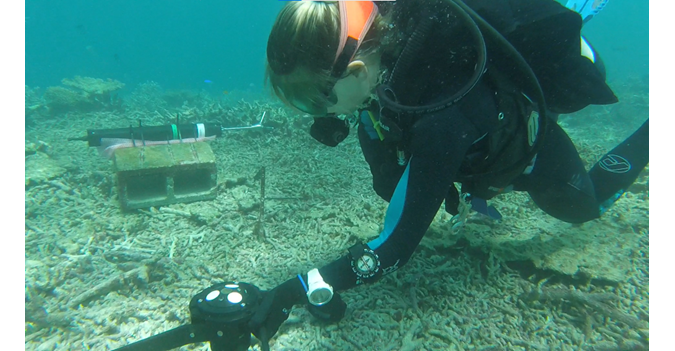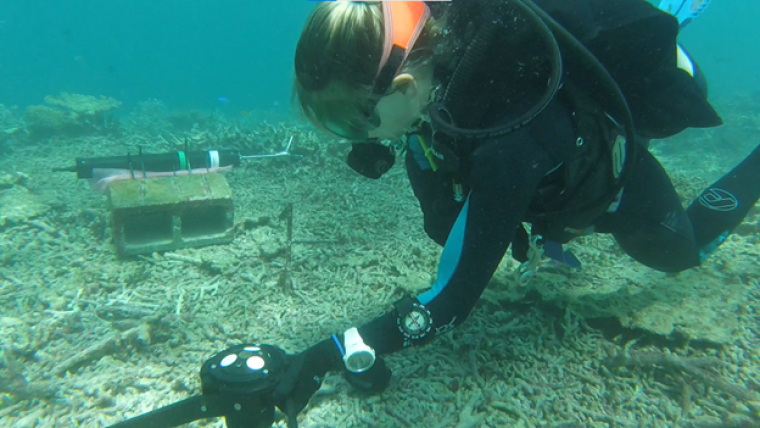Coral reef recovery from the effects of climate change
Researchers at the Heron Island Research Station in Australia are using a Nortek velocimeter to determine how much hydrodynamic energy it takes to move “coral rubble”, the skeletons of corals broken apart by bleaching or storm events in the ocean. Fortunately, researchers have found that stabilizing rubble can be an effective technique for coral reef recovery.
Coral bleaching and storm events can create vast areas of coral rubble on the Great Barrier Reef. If rubble remains in one place for a long time, new, healthy corals can effectively recruit onto it and the reef can recover naturally. However, if the rubble moves around a lot due to waves and currents, new corals living on it can die, hindering recovery. Rubble stabilization interventions can be deployed in areas where the rubble is prone to frequent movement, although we do not yet know where those areas are.
Investigating energy thresholds
“With climate change, we’re going to see more frequent and intense storms and cyclones, as well as coral bleaching events,” said Dr Tania Kenyon, postdoctoral researcher in the Marine Spatial Ecology Lab at the University of Queensland in Australia.
Using a Vector velocimeter designed by Nortek to measure water flow, Dr Kenyon and other researchers correlated the movement of rubble pieces with flow disturbances to determine how much hydrodynamic energy it takes to move coral rubble.
“What we’re doing with the Vector is looking at rubble mobilization thresholds. We’re using it to monitor the hydrodynamic environment while also looking at the movement of rubble pieces,” Dr Kenyon explained. “From previous work I’ve done in the Maldives, we’ve found movement thresholds of about 0.3 to 0.4m/s. We’re furthering that work now on the southern Great Barrier Reef.”
Coral reefs and climate change
“Reefs are very important: millions of people around the world rely on them, they’re important for coastal protection, and they’re one of the most biodiverse habitats in the world,” Kenyon pointed out.
Coral reefs support more species per unit area than any other marine environment and are key to many human development goals, such as supporting sustainable fisheries, discovering new species that can be used in new medicines, and bringing in tourism money to support local economies.
Armed with information on what characterizes sites that could benefit from coral rubble stabilization techniques, the team will develop maps of the Great Barrier Reef that show priority areas for such interventions: areas in the ocean where rubble is moving too frequently for natural coral recovery to occur.
Coral rubble stabilization
Tania Kenyon is part of the Rubble Stabilisation Subprogram team, comprising scientists from the University of Queensland and Queensland University of Technology, including Dr Daniel Harris, who is also working on rubble movement and stabilization.
The subprogramme is part of the Reef Restoration and Adaptation Program (RRAP), which has brought together Australia’s leading coral reef experts and is funded by the partnership between the Australian government’s Reef Trust and the Great Barrier Reef Foundation. This work will contribute to broader-scale research that identifies areas appropriate for rubble stabilization intervention efforts.
Rubble stabilization techniques include structures that are attached to the substrate to pin rubble down or corral it, including biodegradable meshes, rock piles, rebar grids and structures such as MARS Reef Stars. If rubble is stable for long enough, it can then be naturally bound together by sponges, coralline algae and other marine organisms into a stable surface, like bricks and mortar.
Coral restoration techniques
While Dr Kenyon is currently working on the Great Barrier Reef, she is hopeful that the outcomes of this and other research can be used to identify the best coral restoration techniques for reefs worldwide and help reefs navigate the challenges of climate change. “There is hope for our reefs, if we give them the best fighting chance,” said Tania Kenyon. “If we bolster their resilience and foster adaptation through various interventions, while also moving to clean energy, we can hopefully hold onto these crucially important ecosystems.”















